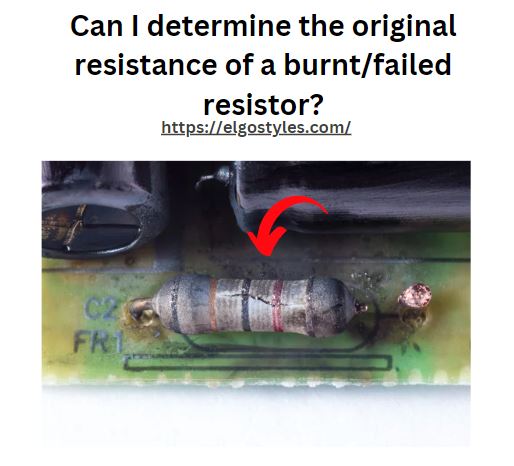Answer:
In most cases, it’s challenging to determine the original resistance of a burnt or failed resistor. The damage caused by burning often alters the resistor’s properties, making it difficult to measure accurately.

Reasoning:
- Physical Damage: Burnt resistors undergo physical changes, such as discoloration or even structural damage, making their original state hard to ascertain.
- Altered Properties: The burning process can change the resistor’s material properties, affecting its resistance value.
- Measurement Difficulty: Burnt resistors may not conduct electricity properly or may exhibit erratic behavior, hindering accurate resistance measurement.
- External Factors: Environmental conditions during burning, such as temperature and voltage fluctuations, further complicate determining the original resistance.
- Limited Data: Without prior knowledge of the resistor’s specifications or measurements before burning, it’s challenging to deduce its original resistance.
- Testing Equipment: Standard resistance measurement tools may not yield reliable results due to the damaged state of the resistor.
- Resistor Type: Different resistor types (e.g., carbon film, metal film) may respond differently to burning, affecting the feasibility of determining original resistance.
- Precision Issues: Even if a measurement is obtained, it might not be accurate enough to reflect the resistor’s original value due to tolerance variations.
- Safety Concerns: Attempting to measure burnt resistors could pose risks, especially if they were damaged due to high voltage or current.
- Professional Assessment: For critical applications or accurate determination, consulting an electronics expert or using specialized equipment may be necessary.
FAQs:
Q: Can burnt resistors be repaired?
A: In most cases, it’s more practical to replace burnt resistors than to repair them.
Q: Why does burning change a resistor’s properties?
A: Burning alters the material structure, conductivity, and resistance, making the original value difficult to determine.
Q: Can I use a multimeter to measure the resistance of a burnt resistor?
A: While possible, burnt resistors may not provide reliable readings due to their damaged state.
Q: What precautions should I take when dealing with burnt resistors?
A: Ensure safety by disconnecting power sources and using appropriate protective gear.
Q: Is it worth attempting to determine the original resistance of a burnt resistor?
A: It depends on the situation; for critical applications, consulting an expert might be necessary.
Q: Can burnt resistors cause other components to fail?
A: Yes, excessive heat or current that damages resistors may affect nearby components.
Q: Can visual inspection alone determine the original resistance of a burnt resistor?
A: Visual inspection provides limited information; accurate measurements are usually required.
Q: Are there any non-destructive methods to determine a burnt resistor’s original resistance?
A: Non-destructive methods are rare due to the physical changes caused by burning.
Q: How can I prevent resistors from burning in the future?
A: Ensure proper circuit design, adequate cooling, and adhere to component specifications.
Q: Can I salvage any components from burnt resistors?
A: In some cases, salvageable components like leads or connectors may be retrieved, but the resistor itself is typically unusable.
 Electrical Engineering World Wiring a Brighter Tomorrow!
Electrical Engineering World Wiring a Brighter Tomorrow!



